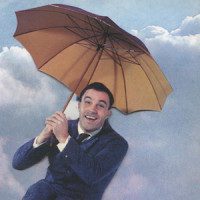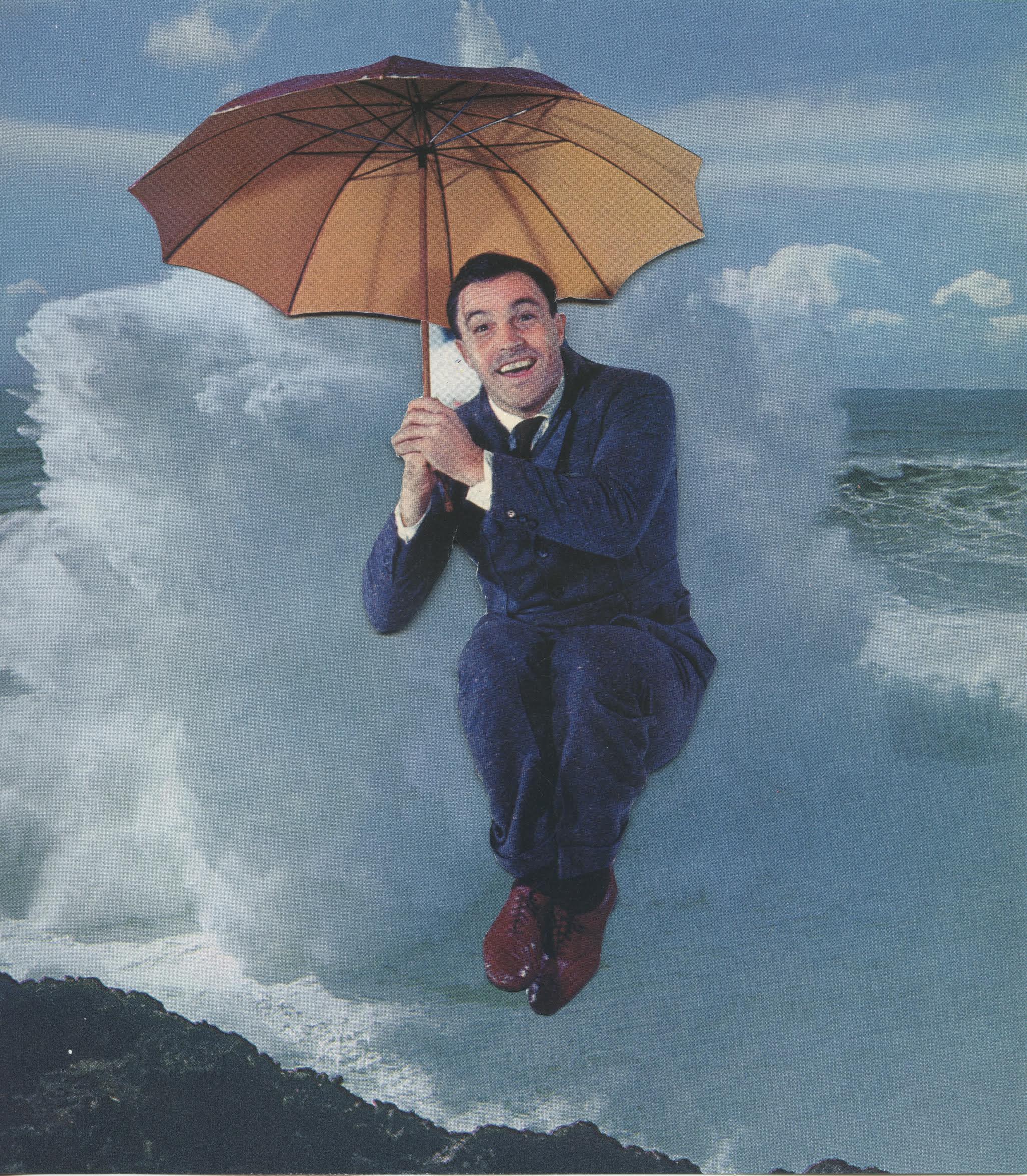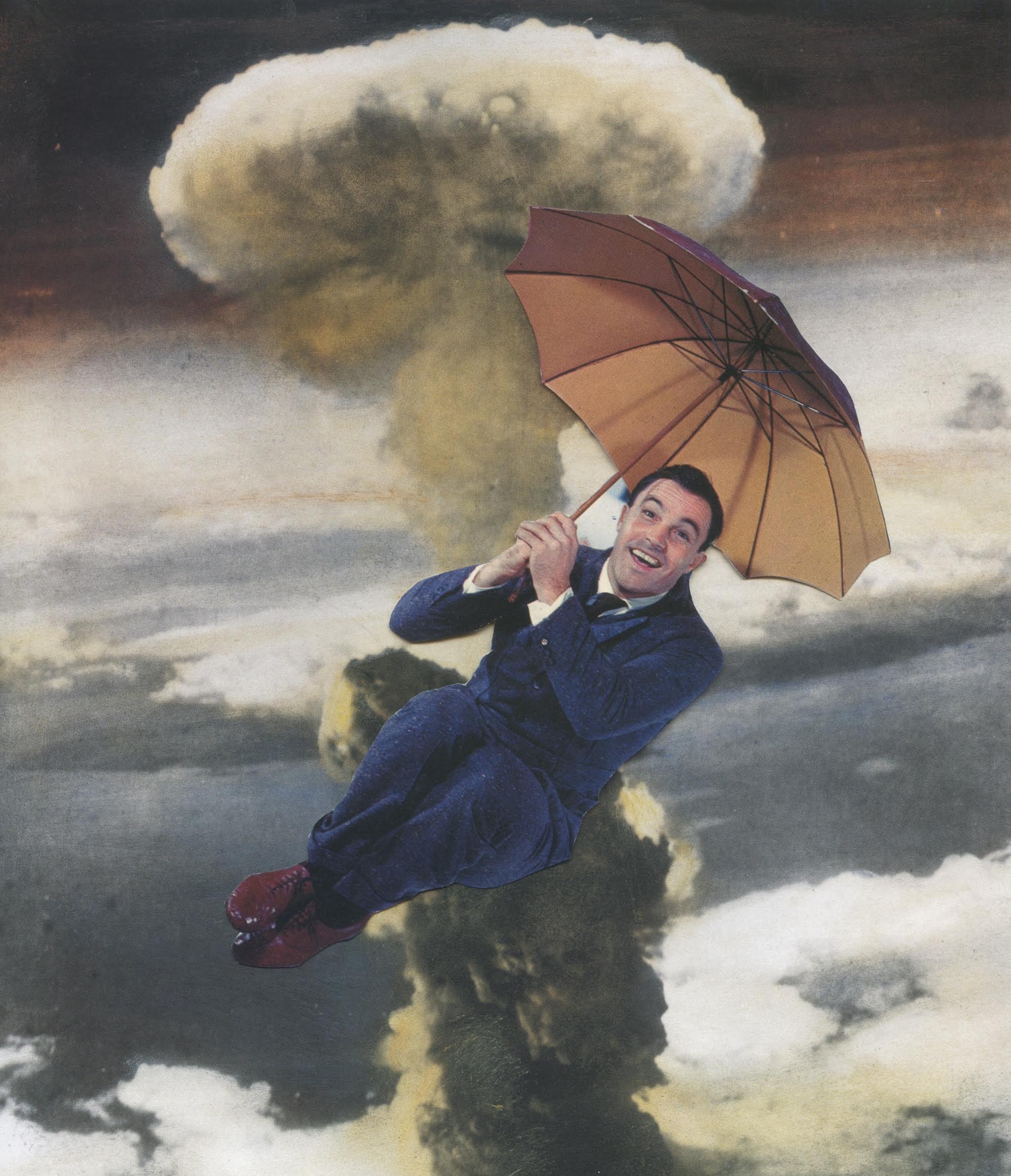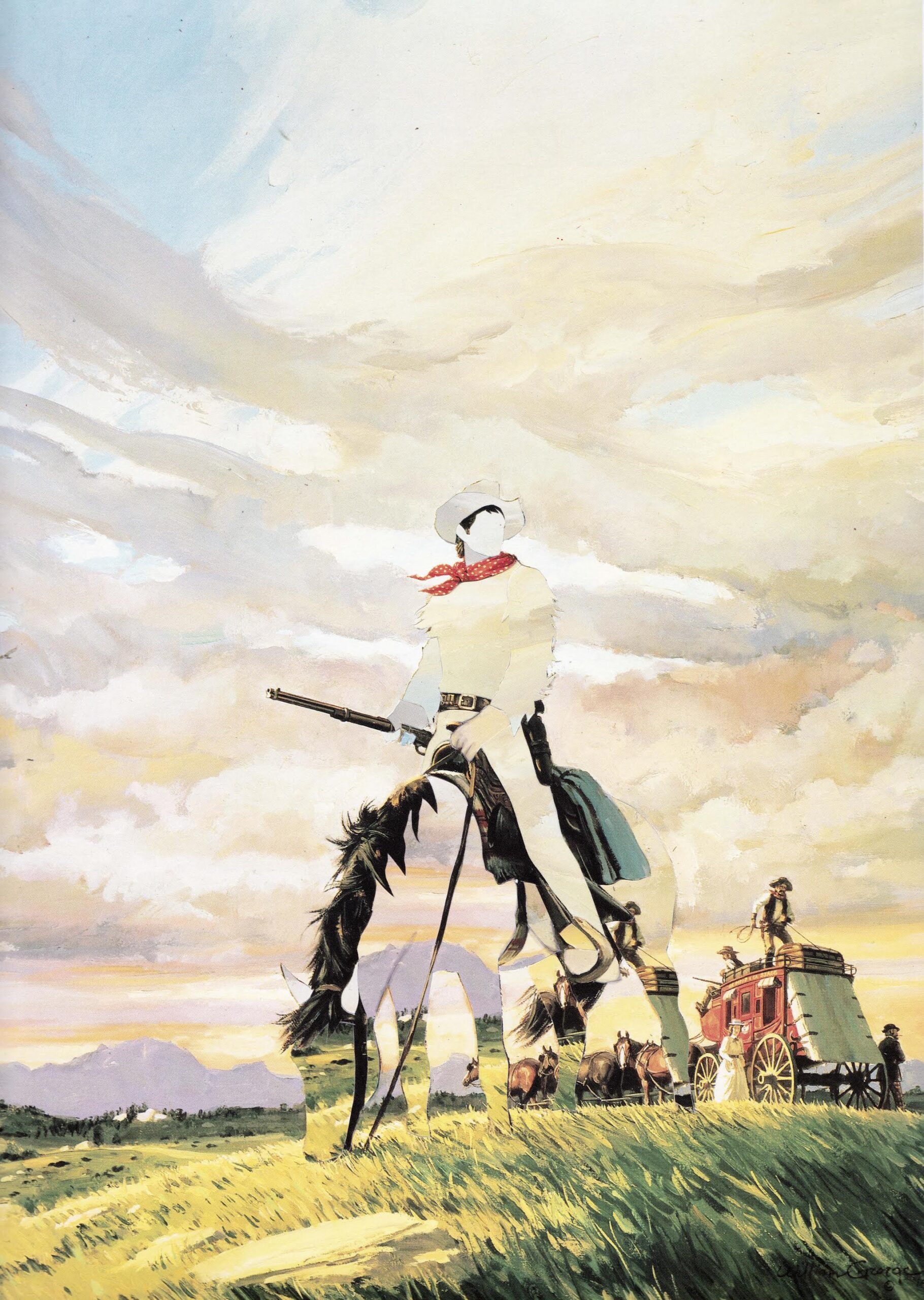Click image to enlarge:
***
Notes on this collage:
- I found this image of Gene Kelly (1912–1996) in a book about Hollywood musicals. It’s from the classic movie, Singing in the Rain. I just re-watched the famous scene where he sings the title song with the umbrella but he doesn’t actually jump in the air with the umbrella open, leading me to believe this image is probably from a promo shot for the movie. It’s pretty amazing how soaked Kelly gets in the scene and still manages to move so artfully.
- After cutting out the image (oh so carefully) I found out that he pretty much looked great in any scene or on any background I stuck him on, so I decided to go a few places with him. I think my favorite is where he’s slightly askew over the mushroom cloud.
- In terms of making a collage, this is pretty much like cheating—find a great image and put it on top of a scenic backdrop and voila! One thing I’ve learned over the past year and a half of collaging is that sometimes simple and minimal is best. If I see a collage that feels a little off, I can usually deduce that it’s because there’s too much happening. In this way, editing a collage can be like editing a poem or a story. The act of taking things out will often make a piece breathe easier and come to life with a simpler beauty. But then again, not everyone will feel that way. Some people want a lot to look at. I’m an unapologetic minimalist.
- “I can test out what the eye is willing to accept.” In the editorial for the new issue of Kolaj Magazine, Ric Kasini Kadour talks about German artist Charline von Heyl and asks, What good is collage? This new issue also includes my interview with Kurtiss Lofstrom.
- The collage postcard exhibit is up until May 12th at the Tucson Jewish Community Center Art Gallery. You can see the top selections from that show on the National Collage Society website.
- I recently launched my own Tumblr just for my collage work. Check it out and follow me there.
- Someone sent me a link to this cool collage collection last week. It’s a special issue of 22 Magazine and features great work by Zach Collins, Aaron Beebe, Bill Zindell, and many others, as well as interviews.
Paper Trumpets Spotlight: Michael Tunk
I’ve called Michael Tunk the Michael Jordan of collage. He’s constantly making spectacular collage work at a constant, head-spinning pace that’s like a slam-dunk highlight reel. The California-via-Midwest artist is constantly striving to innovate and push the world of collage further through his work as well as his support of other collage artists (he’s also constantly doing collaborative collages with other artists, mostly through the mail). The thirty-year-old works in many styles from stark minimalism and sci-fi atmospherics to multi-piece gonzo brain-busters. A sharp and sweet sort of childhood nostalgia permeates some of his best work. I sent him some questions via email.
The Rumpus: How did you get into collage? Like what initially sparked this idea to make them?
Michael Tunk: In high school I did two very large format mixed media collages for a class project and always loved doing those and growing up in a very large family I always collected comic books and family photos and always cut them up. But when my childhood cat died back in 2010 and I moved out to California I lived across the street from a used book store and decided to get a Vietnam book and a big cats book and started making what is now my Big Cats of War series and since then haven’t stopped.
Rumpus: You’re so prolific. Do you have a jobby job? What do you do with every 24 hours?
Tunk: My partner and I had a baby girl back in 2013 and since then I’ve been a stay-at-home dad. So that’s been my job up until now. But I did recently start working at an antique store here in town. Every 24 hours it’s getting up early taking care of Tigerlilly while Cara (her mom) goes to work. In between her taking naps I either work on getting images together or plan in my head what I am going to work on next. Then when Cara gets home from work, after having dinner, I’m off to the studio where I work from between 8-10 p.m. Then I start again in the very early hours of the morning.
Rumpus: You’ve become a regular artist for Lucky Peach. How did that come about? Doing any other magazine work?
Tunk: I’ve been a huge fan of a band called the Magik Markers for a very long time and always gave them artwork at shows. Once I went and saw a side project of the band called Spectre Folk. The guitarist of Spectre Folk is also one of the founding editors of Lucky Peach and out of the blue asked me if I wanted to do the cover of a 45 for the Lucky Peach record club for the Magik Markers. Which to me was a dream come true. So I did it and they loved it and ever since then I’ve had the opportunity to work for them, which has been so unbelievably amazing. Crazy how it all worked out. As for other magazines not as of yet. But I really need to start pushing myself to get to work for others.
Rumpus: In your Unknown Riders series, you somehow make the main character seem invisible, but there’s the hint of an outline. What was your inspiration for this? How do you do it? Was it initially an accident?
Tunk: I’ve always been a huge fan of Sergio Leone and other westerns for as long as I could remember. But while making the Wild West Guide to the Galaxy series I had these cut outs left over from old Disney Little Golden Books and loved how they looked with the negative space. So at first I started using a bunch of little bits of other cut outs and tried to create a mini story within the negative space and eventually that turned into wanting to push them further and make the character literally invisible. I then became obsessed with doing this with old dime store cowboy novels, which has now led to this latest version in the series where I feel they have been completely fine-tuned. The new way of doing them though I will leave to the imagination.
Rumpus: You tend to do a lot of things in series, like the Big Cats of War. What do you enjoy or search for when doing a bunch of these themed works?
Tunk: I really loved to work with things that I’m comfortable with working with. Usually things I grew up loving i.e. Big Cats, War imagery, cowboys, etc. So I always have an eye out for all of these things. As a collage artist I feel it’s important to really always have an idea of what you are looking for and always go through everything you have. It’s really important to know what you have and what you want if that makes any sense.
Rumpus: I’ve been thinking a lot lately about how people get their collage work seen by people. What’s your advice for collagists—especially newer people doing it—in regards to where they post or publish or sell?
Tunk: For me personally I always stuck to using Tumblr and Instagram. Instagram especially though! I’ve sold more work through that than any gallery or website. Kind of crazy, really. For people who are really new at this I really recommend the Facebook and/or Flickr groups; they really help with getting your work out to the community. And the community is truly beautiful and everyone is really great and caring. It also helps to find any submitting places, like Laura Tringali Holmes’s The Target Practice Project. Stuff where it’s getting out there. Also to not be scared asking people in our community to collaborate. It helps you grow as an artist and is a truly amazing way to work outside of your box.
Rumpus: What’s sort of things do you have coming up?
Tunk: Hopefully by the end of summer I will be releasing a 100+ page book of the newer Unknown Rider stuff. In August/September I am curating a huge solo/group Big Cats of War show. In June, a big group show I got to curate called Small Worlds. In July I’ll have some things in Winston Smith’s Instagram show at The Collage Museum. Plus many more things.
Rumpus: What do you think you’ll be doing in the year 2020?
Tunk: Hopefully doing the same thing I’m doing now—making what I love and watching my beautiful baby girl grow up.








